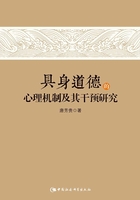
五 总讨论
实验一的研究结果表明,由于社会冷漠导致的长期孤独感可能会使被试更渴求物理(或身体)温度的体验,如在日常社会洗澡次数更多、用时更久和更偏爱热水,这为我们研究的核心假设——物理温度与心理温度的互替性提供了初步的相关性证据。
实验二的实验结果表明,冷温度觉的启动可以有效诱发被试的社会孤独感,与钟和莱奥纳尔代利(2008)的实验结论相互支撑。这为物理温度与心理温度的互替性假设提供了有力的实验证据,也充分证实了物理温度与心理温度存在双向性的隐喻关系。
实验三的实验结果表明,经历社会冷漠体验的被试在感受了温暖的物理温度后,明显地降低了对他人的亲和需要以及寻求调节情绪活动的需求。这实际上表明,对于遭受社会排斥和道德冷漠的人们来说,物理性的温暖体验是一种简单易行且可靠的自我治疗手段。当然,这也是物理温度与心理温度互替性假设的强力实验证据。
值得一提的是,有关身体疼痛和心理疼痛关系的实验研究结果证实,身体疼痛和心理疼痛的脑区存在重叠,神经工作机制基本相似,并且遭受社会排斥的脑区激活和身体疼痛的脑区激活是重叠的。[20]
以上研究结果对心理治疗实践甚至身心的医疗治理实践具有重要的启示意义。在心理治疗实践中,辩证行为疗法(DBT)是一种新兴的主要针对边缘性人格障碍的心理疗法,对帮助人们掌控压迫性情绪非常有效。温暖的物理温度调节方法注重运用非对抗和非破坏性的方式来进行自我安抚、调整自我感觉,应该可以成为辩证行为疗法的一种简单实用的情绪调节方法,应用前景光明。季节性情绪失调是外部环境(如温度、日照)的大幅度波动所导致的心理性温度(情绪)失稳,物理温度与心理温度的替代性也可为此类心理疾病提供可借鉴性的治疗手段。当前中国正进入老龄化社会,由于中国特殊的人口政策,许多老人正在感受空前的社会孤独感,生活质量有待提高。在老人真实的社会孤独感不能得到真正解决之前,物理温度的调节不失为一种现实可行的方法。这是因为温暖的温度体验能够有效地降低社会冷漠体验和部分替代社会温暖体验,并且能够有效减少由社会性孤独所带来的归属需求。因此,本研究的结果可为公共卫生的实践提供重要的理论参考和实践依据。
[1] Asch, S. E., “Forming impressions of personality”, Journal of Abnormal and Social Psychology, Vol.41, No.2, Mar 1946.
[2] Kelley, H. H., “The warm-cold variable in first impressions of persons”, Journal of Personality, Vol.18, No.4, Jun 1950.
[3] Fiske, S. T., Cuddy, A. J. C., & Glick, P., “Universal dimensions of social cognition: Warmth and competence”, Trends in Cognitive Sciences, Vol.11, No.2, Feb 2007.
[4] Asch, S. E., The metaphor: A psychological inquiry, In R. Tagiuri & L. Petrullo (Eds.), Person perception and interpersonal behavior(pp.86-94), Stanford, CA: Stanford University Press, 1958.
[5] Barsalou, L. W., “Perceptual symbol systems”, Behavioral and Brain Sciences, Vol.22, No.4, Aug 1999.
[6] Mandler, J. M., “How to build a baby:Ⅱ. Conceptual primitives”, Psychological Review, Vol.99, No.4, Oct 1992.
[7] Williams, L. E., Huang, J. Y., & Bargh, J. A., “The scaffolded mind: Higher mental processes are grounded in early experience of the physical world”, European Journal of Social Psychology, Vol.39, No.7, Nov 2009.
[8] Bowlby, J., Attachment and loss: Vol.1. Attachmen, New York, NY: Basic Books, 1969.
[9] Harlow, H., “The nature of love”, American Psychologist, Vol.13, No.12, Aug 1958.
[10] Williams, L. E., & Bargh, J. A., “Experiencing physical warmth promotes interpersonal warmth”, Science , Vol.322, No.5901, Oct 2008.
[11] IJzerman, H., & Semin, G. R., “The thermometer of social relations: Mapping social proximity on temperature”, Psychological Science , Vol.20, No.10, Jun 2009.
[12] Kang, Y., Williams, L., Clark, M., Gray, J., & Bargh, J., “Physical temperature effects on trust behavior: The role of insula”, Social Cognitive and Affective Neuroscience , No.6, Aug 2010.
[13] Zhong, C. B., & Leonardelli, G. J., “Cold and lonely: Does social exclusion literally feel cold?”,Psychological Science , Vol.19, No.9, Sep 2008.
[14] IJzerman, H., & Semin, G. R., “Temperature perceptions as a ground for social proximity”, Journal of Experimental Social Psychology , Vol.46, No.6, Nov 2010.
[15] Craig, A.D., Chen, K., Bandy, D., & Reiman, E.M., “Thermosensory activation of insular cortex”, Natural Neuroscience , Vol.3, No.2, Feb 2000. Todorov, A., Baron, S.G., & Oosterhof, N.N., “Evaluating face trustworthiness: A model based approach”, Social cognitive and Affective Neuroscience , Vol.3, No.2, Jun 2008. Kross, E., Egner, T., Downey, G., Ochsner, K., & Hirsch, J., “Neural dynamics of rejection sensitivity”, Journal of Cognitive Neuroscience, Vol.19, No.6, Jun 2007.
[16] Craig, A. D., “How do you feel-now? The anterior insula and human awareness”, Natural Reviews Neuroscience , Vol.10, No.1, Jan 2009.
[17] Russell, D., “The UCLA Loneliness Scale (Version 3): Reliability, validity, and factor structure”, Journal of Personality Assessment, Vol.66, No.1, Feb 1996.
[18] IJzerman, H., & Semin, G. R., “Temperature perceptions as a ground for social proximity”, Journal of Experimental Social Psychology , Vol.46, No.6, Nov 2010.
[19] Baumeister, R. F., Bratslavsky, E., Finkenauer, C., & Vohs, K. D., “Bad is stronger than good”, Review of General Psychology ,Vol.5, No.4, Aug 2001.
[20] Eisenberger, N. I., Lieberman, M. D., & Williams, K. D., “Does rejection hurt? An fMRI study of social exclusion”, Science ,Vol.302, No.5643, Oct 2003. Panksepp, J., “Feeling the pain of social loss”, Science , Vol.302, No.5643, Oct 2003.